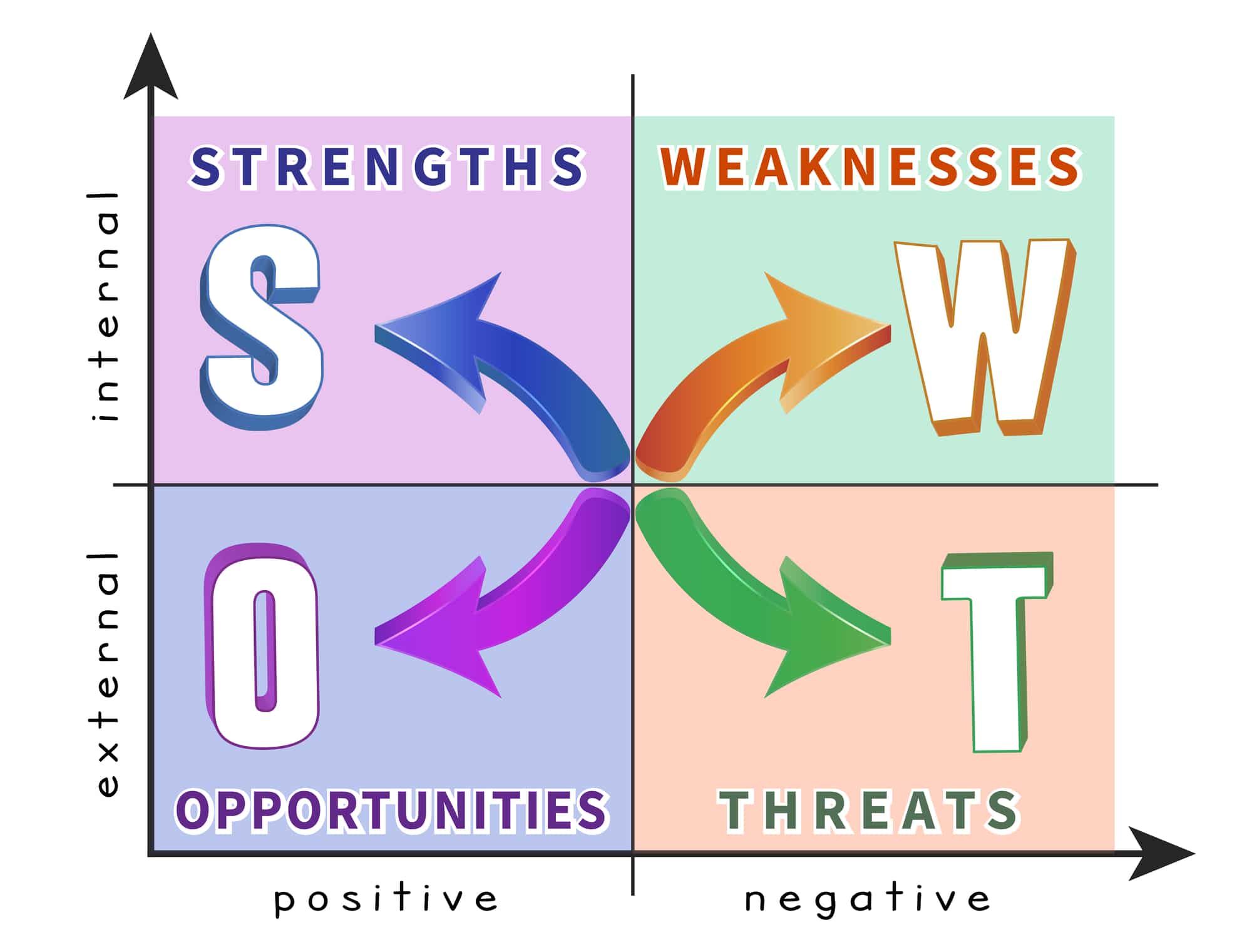What is a SWOTT analysis and how is it different than a SWOT analysis? What kind of questions need researchers to ask? SWOTT analysis examples included.
If you have found your way to this article, chances are that you know a thing or two about strategic planning tools. You may have heard of SWOT analysis which is one of the most basic of such tools. A SWOTT analysis, however, is a bit different from its counterpart. This article is aimed at explaining what is a SWOTT analysis and how it differs from the basic SWOT analysis.
No successful organization can survive without proper strategic planning. While the term may sound complicated, the strategic planning process is fairly simple, with five steps that involve selecting goals and the ways to achieve them.
This process comprises certain components over which tools and techniques can be applied. The strategic planning process consists of five main steps which include visioning, choosing goals, adding milestones, circumstance analysis, and revision.
There are a number of tools and techniques that can help in every stage of the strategic planning process. Such tools include SWOT analysis, PEST analysis, scenario planning, and competitor analysis.
Another tool that is perhaps not as commonly heard of is SWOTT analysis, which is the focus of this article.
If you would like to know about strategic planning in detail, you can always find helpful articles such as What is strategic planning?
What is SWOT analysis?
There was a time when terms such as strategic planning or SWOT analysis were limited to the field of management sciences, however, that may not be true anymore. For those of you who are curious to know what a SWOT analysis is, let’s take a look.
A SWOT analysis is a tool that is mostly used during the evaluation stage of the strategic planning process because it allows companies to look at the current and near-future situations for a business.
In fact, it is often used interchangeably with and mistaken for strategic planning itself!

SWOT Analysis
A SWOT analysis is particularly helpful for companies who want to find out how they are currently performing, how they can improve, and what potential problems they should be aware of.
It consists of four basic dimensions or components namely a company’s strengths (S), weaknesses (W), opportunities (O), and threats (T). Strengths and weaknesses are internal factors for the company which it can control and opportunities or threats represent external factors that may affect the organization but cannot be directly controlled by it.
Strengths (S) represent what a company is already good at and these can be used to stay ahead of competitors. Whereas the weaknesses (W) of a company are factors that the organization needs to deal with or improve in order to compete effectively.
On the other hand, opportunities (O) represent the key factors that may benefit a company if it chooses to avail them on time. Such opportunities can help companies improve their competitive position in the market.
The “T” in SWOT, stands for threats that a company faces due to factors existing outside the organization. While the company cannot control threats directly, it can lessen their impact on its performance by taking pre-emptive measures such as coming up with contingency plans.
SWOT Analysis Steps
It's fairly simple to carry out a SWOT but you must remember that you don't have to conduct it for the entire organization, it can be for a division or even a particular product. To learn how to do a SWOT analysis, you can use 4 main steps.
Firstly, list down all the strengths, which represent the strong points of a company. Move on to listing down the company’s weaknesses i.e. where does it need improvement.
Now, look towards external opportunities which the company can use to improve its standing in the market. Once you are done with that, take a look at the threats that the company might have to look out for.
SWOT Analysis Templates and Tabular Form
To make things simpler for a company and save time, a pre-existing template can be used to analyze the factors that comprise a SWOT analysis. Such templates are in a structured format to facilitate understanding.
Or you can use a SWOT table to visually depict the elements of SWOT analysis. You can also take a look at some examples of SWOT analysis for further concept clarity.
SWOTT Analysis
While the first four letters of the acronym; strengths (S), weaknesses (W), opportunities (O), threats (T) are similar to the traditional SWOT analysis, this tool takes an additional factor into consideration, namely, trends (T).
SWOTT is not only helpful when starting a new venture, but can also help when you are already operating a business.
Strengths (S)
The “S” in SWOTT stands for the strengths of a company, which is basically what the company is already good at. The question is how do you identify these strengths? It’s simple, take input from all the key people associated with your business, these can be individuals outside your business such as suppliers, industry experts, or even your own employees!
Don't forget to ask some important questions which may include; what does our company do best? According to other people, what are the key strengths of our company? And what are the benefits of being the type of business we currently are?
Weaknesses (W)
While it may not be easy to admit it, every company has its weaknesses. Keep a positive attitude and remember that if you address your weaknesses at the right time and work towards improving yourself, they may just become your strengths!
It can also help to ask some relevant questions. What are some areas in which the business needs improvement? Which problems keep recurring? What could the business do better?
Opportunities (O)
While opportunities are usually viewed as being external factors for the firm, they can also be internal in nature.
For instance, can changing an internal process result in growth opportunities? Furthermore, keeping an external outlook, what are some opportunities that the company can avail? How will these opportunities allow it to compete more effectively?
Threats (T)
If you've been too busy simply going about your day and focusing on what you're already good at, chances are that external threats might take you by surprise. A major part of effective strategic planning is keeping the bigger picture in mind, which involves looking beyond the firm.
Keeping an eye out for looming threats that might strike at a moment's notice, is perhaps one of the most difficult tasks for management personnel. To counter this shortcoming, it can help to take input from more people.
Having a contingency plan in place for when a threat may arise, is helpful for companies who cannot afford to be caught unaware.
Trends (T)
An additional element to keep in mind is the trends that are dominant in the industry where the business is currently operating or wishes to operate. Unlike the other four components, this factor is not subjective in nature, rather it is based on facts and should be treated as such.
Companies can identify trends by taking a look at popular magazines relevant to their industry of choice. They can also take a look at tradeshows, new products, and the news to get a better idea of current or upcoming trends.
Some questions to ask are; What are the current trends in the chosen industry? How do these trends differ according to local, national, and international perspectives? What are the consumer spending trends? Is it increasing or decreasing?
It is important to remember that the elements of SWOTT, particularly trends (T), are time-sensitive which means that these factors have to be re-evaluated after a certain time has passed.
It is also important to note that carrying out a proper SWOTT analysis can be quite taxing and time-consuming which prevents managers from giving it their all. A solution might be to hire an external expert who can do it for you, while you spend your energy on evaluating all the relevant aspects and providing accurate information.

SWOT VS SWOTT analysis
While the first four elements of SWOTT analysis are the same as the basic SWOT analysis that is taught to every management student, there is an addition of one more factor to be considered which is the industry trends. This change is fairly recent and it involves keeping the current trends of the industry, in which the business exists or wants to enter, in mind when formulating a strategy.
These trends are particularly time-sensitive which is why a SWOTT analysis may be slightly more thorough and hence more complicated than a traditional SWOT analysis. It may also require the factors to be re-evaluated sooner than a SWOT analysis because trends change faster than the other four factors.
How to design a SWOTT analysis?
Once you have answered the relevant questions and identified the characteristics of the company related to each element of the SWOTT analysis, it is time to design it.
Unlike a regular SWOT analysis, a SWOTT analysis consists of a chart divided into five squares where each square represents the strengths (S), weaknesses (W), opportunities (O), threats (T), and trends (T) respectively.
Free online templates can be used to carry out a SWOTT analysis and there are also tools available to help in this endeavor. These tools include the likes of Canva, google docs or sheets, word docs, and excel sheets.
The last stage involves figuring out how to implement the SWOTT analysis such that the company is able to increase its strengths, reduce its weaknesses, avail new opportunities, face threats and cater to current trends in the industry.

An Example of SWOTT Analysis
To make it easier to understand SWOTT analysis, let's take the example of Deliveroo which is a food delivery service that initially started in London, UK.
In the beginning, Deliveroo was at the top of its game, with little to no competition it had a strong foothold in the food delivery industry, however, over time the situation changed.
While Deliveroo could boast of its strengths (S), such as its superior service quality, strong partnerships and short order time, its weaknesses (W) were also a glaring reality. These included the ineffective response to the Covid-19 pandemic and PR problems arising from issues related to human resource management.
However, Deliveroo did have opportunities (O) to improve its position in the market by making use of new technologies for more efficient order processing and tracking. However, threats (T) such as strong competition and legal issues were also a reality.
If Deliveroo carried out a simple SWOT analysis, it might lose sight of a very important market trend i.e. the consumers' increasing preference for healthy foods. A SWOTT analysis that also focuses on such trends, makes it a better tool for companies who do not want to miss out on such lucrative opportunities.
SWOTT Analysis: Conclusion
So if a company is serious about analyzing its performance and wants to come up with the best possible strategies that will allow it to step ahead of its competitors, a SWOTT analysis might be a better option than the traditional SWOT analysis.
While a SWOTT analysis is decidedly more time-sensitive than its traditional counterpart, due to the ever-changing nature of industry trends, it is also more thorough and hence allows all companies to uncover more profitable market opportunities.

PESTLE Analysis
Yet another strategic planning tool that is slightly more advanced than a SWOT analysis is the PESTLE analysis which takes into account the external entities that may affect the company or project. Simply put, a PESTLE analysis is a tool used to assess the environment in which the company is operating.
It consists of political (P), economic (E), social (S), technological (T), legal (L), and environmental factors (E). These factors are explored in detail in the following article: What is PESTLE Analysis? An Important Business Analysis Tool.
All of these 6 factors are incorporated in the PESTLE framework, it is important to note that all of these factors are interdependent. To make things even simpler, you can use a template for carrying out this analysis.
PESTLE analysis involves using a simple 5-step process to study and assess the environment in which the company is operating. Companies that are committed to improving themselves can use this analysis in addition to a SWOT or SWOTT analysis to make even better decisions.


